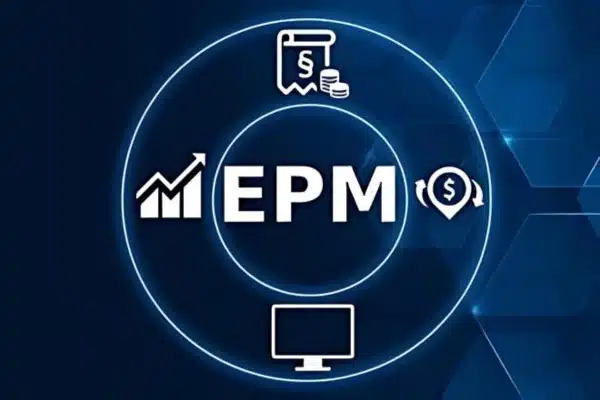Introduction to EPM
In today’s dynamic business environment, organizations face increasing pressures to improve performance, adapt to changing market conditions, and ensure long-term growth. This is where Enterprise Performance Management comes in. It is a comprehensive approach that helps organizations measure, manage, and optimize their performance across various dimensions—financial, operational, and strategic.
What is EPM?
Enterprise Performance Management refers to the suite of processes, methodologies, metrics, and technologies that organizations use to manage and monitor their performance. It integrates key aspects of business management, such as strategic planning, budgeting, forecasting, financial reporting, and performance analysis, to ensure the organization aligns with its overall objectives.

Why is Enterprise Performance Management Important?
In an increasingly competitive market, aligning an organization’s operational execution with its strategic goals is crucial. EPM allows businesses to:
- Stay competitive by making data-driven decisions.
- Improve the accuracy of financial planning and budgeting.
- Increase transparency and accountability within the organization.
- Identify areas for growth and operational efficiencies.
Evolution of EPM
Initially, EPM revolved around basic financial planning, budgeting, and static reporting, often managed manually or with early digital tools like Lotus 1-2-3 and Excel. Each line of business operated in a silo, and finance teams were challenged to consolidate departmental objectives, budgets, and data into a single, cohesive strategy for the business. This was time-consuming work prone to human error—made even more difficult by ever-changing regulatory and tax laws. Stale and inaccurate data introduced additional challenges, making it impossible to respond quickly to changes in the business—with under-performing results not coming to light until much later in the cycle.
By the early 2000s, dedicated EPM platforms such as Oracle Hyperion and SAP BPC introduced advanced planning, real-time forecasting, and scenario analysis, enabling organizations to align strategies and enhance decision-making. The rise of cloud computing in the 2010s revolutionized EPM, making it more accessible and scalable. Cloud-based solutions like Anaplan and Adaptive Insights allowed organizations to collaborate seamlessly across geographies, access real-time data, and benefit from continuous software updates without hefty infrastructure costs. Modern EPM systems harness AI and machine learning for predictive analytics, automation, and personalized insights, integrating with big data and ESG metrics for sustainable management. Future trends like hyper-automation and augmented decision-making will solidify EPM as a key driver of strategic success in navigating business complexities.
Components of Enterprise Performance Management
EPM encompasses several core components that work together to ensure effective performance management. These components help organizations focus on the most important aspects of their performance and maintain a strategic edge.
1. Financial Planning and Analysis (FP&A)
Financial planning and analysis involve forecasting, budgeting, and financial modeling. FP&A helps business leaders assess financial performance, make informed decisions, and ensure that financial resources are allocated efficiently across the organization. Accurate budgeting and forecasting allow businesses to anticipate future needs and take proactive steps to address potential challenges.
2. Strategic Planning
Strategic planning is the foundation of EPM. It involves setting long-term business objectives and developing a roadmap to achieve them. This process requires leadership to define key goals, allocate resources effectively, and track progress toward these goals. Strategic planning ensures that everyone in the organization is working toward common objectives and that the company is adapting to industry changes.
3. Performance Measurement
Performance measurement refers to setting and monitoring key performance indicators (KPIs) and metrics that track how well the organization is achieving its objectives. KPIs can include financial metrics like revenue growth, profitability, and ROI, as well as operational metrics like customer satisfaction, employee performance, and market share. Dashboards and real-time reporting tools make it easier to visualize performance across departments.
4. Consolidation and Reporting
Consolidation involves bringing together financial data from various departments or subsidiaries to create a unified view of the company’s performance. This process ensures consistency and accuracy in financial reports, making it easier for stakeholders to understand the organization’s financial health. Automated reporting tools can significantly streamline this process, reducing errors and time spent compiling data.
5. Scenario Planning
Scenario planning involves creating multiple potential business scenarios to assess how different decisions, market conditions, or external factors might impact the organization. By considering different outcomes, businesses can plan for uncertainties and develop strategies to mitigate risks. Scenario planning helps organizations remain agile and make informed decisions in rapidly changing environments.
Impact of Technology in Shaping EPM Strategies
- Cloud Computing: Cloud-based platforms have revolutionized EPM, providing flexibility, scalability, and cost efficiency. Tools hosted on the cloud allow organizations to access data in real-time, collaborate seamlessly, and benefit from continuous updates. Examples include Oracle EPM Cloud and SAP Analytics Cloud.
- Artificial Intelligence (AI) and Machine Learning (ML): AI and ML algorithms drive predictive analytics, trend analysis, and scenario planning. These technologies enable organizations to uncover insights from large datasets, automate repetitive tasks, and make proactive decisions. Examples: AI-powered tools in Anaplan and Workday Adaptive Planning.
Big Data and Advanced Analytics: Big data technologies like Hadoop and Spark help EPM systems process and analyze vast datasets, providing actionable insights. Coupled with analytics tools, EPM platforms can integrate financial and non-financial metrics to ensure holistic performance tracking. - Robotic Process Automation (RPA): RPA automates routine, rule-based tasks like data entry, report generation, and workflow approvals, enhancing efficiency and reducing human error. Tools like UiPath and Blue Prism are often integrated into EPM systems.
- Visualization and Reporting Tools: Modern EPM systems rely on advanced visualization and reporting tools to simplify complex data and present actionable insights. Platforms like Power BI, Tableau, and QlikView are widely used for creating interactive dashboards and customizable performance analysis. These tools enable organizations to analyze metrics effectively, offering real-time visual insights that drive informed decision-making and strategic alignment.
- Collaboration and workflow management tools: These are equally vital in EPM to ensure seamless teamwork and task coordination. Solutions like Microsoft Teams and Slack facilitate real-time communication and updates, while tools such as Trello and Asana help manage tasks, track progress, and streamline workflows. By integrating these tools into EPM processes, organizations enhance productivity and maintain alignment across teams.
- Security and Compliance Technologies: To ensure data security and regulatory compliance, EPM platforms incorporate robust technologies. Features like data encryption safeguard sensitive information, while audit trails provide accountability by tracking changes. Built-in compliance modules address industry regulations such as SOX, GDPR, and IFRS, ensuring organizations can manage performance securely and meet legal obligations effectively.
Advantages of Implementing Enterprise Performance Management
Implementing an effective EPM strategy offers numerous advantages, particularly in improving operational efficiency and aligning strategic goals with business execution. Improved Decision: Making EPM provides real-time access to accurate and comprehensive data, allowing business leaders to make informed decisions quickly. With KPIs, financial forecasts, and performance reports readily available, decision-makers can assess the impact of their choices before making them.
- Cost Optimization: By identifying areas of inefficiency and streamlining processes, EPM helps organizations optimize costs. For instance, businesses can identify underperforming departments or areas with high operating costs and take corrective actions.
- Increased Agility: EPM allows businesses to respond more quickly to changes in the market, whether it’s a shift in customer demand, a new regulatory requirement, or a disruptive technology. With real-time data and scenario planning, businesses can pivot quickly and ensure continued success.
- Alignment of Goals: EPM ensures that all levels of the organization—from executives to frontline employees—are working toward the same strategic goals. This alignment boosts collaboration and helps the organization stay focused on its core objectives.
- Enhanced Accountability and Transparency: EPM systems provide clear visibility into performance at every level of the organization. This transparency fosters accountability, as employees can see how their actions directly impact organizational performance. Managers can also track progress toward goals and address any performance gaps.
Challenges Faced in Enterprise Performance Management
While the benefits of EPM are significant, there are also challenges that organizations may face during implementation.

- Complexity: EPM systems can be complex to implement, especially for large organizations with diverse operational needs. Integrating various business functions, aligning them with EPM strategies, and training staff on new systems can be time-consuming.
- Data Integration: Issues Data from different departments, divisions, or subsidiaries may be stored in disparate systems or formats. Ensuring seamless data integration across these systems is crucial for accurate and consistent reporting. Poor data quality can undermine the effectiveness of EPM.
- Resistance to Change: Employees and managers may be resistant to adopting new processes or technologies. Overcoming this resistance requires effective change management, clear communication, and training to ensure that stakeholders are on board with the EPM implementation.
- Cost of Implementation: The upfront cost of implementing an EPM solution, including software, training, and consulting, can be high. While EPM offers long-term benefits, organizations must be prepared for the initial investment.
Notable Enterprise Performance Management Platforms
1) Hyperion: A traditional favourite, Hyperion provides on-premise and cloud-based solutions for financial planning and analysis, reporting, and consolidation.
2) OneStream: Known for its unified platform, OneStream streamlines financial close, consolidation, planning, and reporting processes. Its Marketplace offers additional modules for specific needs.
3) Oracle EPM Cloud: A comprehensive cloud-based platform offering tools for planning, budgeting, reporting, and compliance. It integrates AI for predictive analytics and scenario modelling.
4) SAP Analytics Cloud: Combines EPM capabilities with business intelligence and predictive analytics. It’s designed for seamless integration with SAP ERP and other data sources.
5) Anaplan:A highly flexible cloud-based EPM tool focused on planning, forecasting, and scenario analysis. It offers robust collaboration features and integrates with various data sources.
6) Workday Adaptive Planning: A user-friendly platform providing budgeting, forecasting, and workforce planning capabilities. It’s ideal for organizations looking for scalability and automation.
Conclusion
Enterprise Performance Management (EPM) is crucial for optimizing organizational performance. It streamlines decision-making, enhances efficiency, and aligns business goals, making it essential in today’s dynamic market. To learn more about how EPM can drive business success, explore Oracle's Enterprise Performance Management solutions.

Looking ahead, Enterprise Performance Management will evolve with AI, machine learning, and analytics, keeping businesses agile and future-ready. Adopting it today ensures innovation, resilience, and long-term success.

